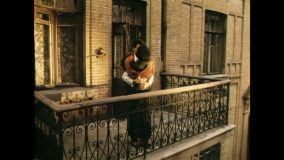THE RED DUST, DIR. YIM HO (1990)
A Traditional Apartment, Changchun

The most iconic scene on the balcony
Apartment: conflict generator between private space and public space
At a mere mention of romance movie, commonly, the first impression upon the plot is its core structure – a narration centred at a couple, a trinity or a more complex relationship, accompanied by extensions and developments to broader scenarios. Multiple devices would be employed to improve the tension of the film. This article would focus on the contributions of the locale in romantic movie. Discussions would base on the Red Dust directed by Yim Ho in 1990. The film is set under anti-Japanese War and the Second Civil War of China, charting a romance story filled with separations and disturbances between Shen Shaohua, a female writer who the sensitive heroine bred up by an old-fashioned Chinese family and Zhang Nengcai, the reader and adorer of Shen with an identity of traitor to his motherland.
The film was photographed in Changchun, a city with archetypal sites of that period due to the occupation of the Japanese. One major locale in the film is a traditional apartment where Shen dwells in. This article aims to elaborate on how apartment serves as a device to generate conflicts between private core and public surrounding which would map onto the plot of the film.
Apartments are always essential in film narration. According to Wojcik, P. R. (2018), apartment plot can create “a spectrum of familiarity” to the spectators of the film. He also mentions that apartment as a reflection of suburban living under certain historical epoch, could induce a touristic perspective for the viewers. To apply a component of daily world as a tool for film narration makes the presentation of plots closer to common life. Apartment is appropriate to be the bridge between the audience and the plots. They tour inside the scenes of the film with full engagement rather than outside viewers. Under such condition, tension of the film could reach the expected level.
The apartment in the Red Dust is a typical two-floor architecture in the 1930s and 1940s with western construction style and a rectangular courtyard. Neighbours reside in single rooms and share common stairways, corridor and living room. Consistency of the entire space is torn into isolated private units, however, the adjacent relationship between these units still maintains a considerable degree of connections. Such residential pattern has some similarity to hall life of Hong Kong colleges, which permits a relative independence of dormitories but still shares a common life. The familiarity between residents in the hall enables a balance between privacy and openness in the surrounding. However, in a neighbourhood where the trust between people is apparently more vulnerable, the semi-open apartment surrounding makes voyeurs of private space available. Hence, when the outsiders from the core become voyeurs, an “invasion” to the core is unavoidable. Afterwards, a conflict between private space and public space can become the consequence of that. Such conflict would map on the plot eventually.
One clue of conflict in this film is generated inside the apartment. The core consists of Shen and Zhang, and their private space is Shen’s room. The narrow space is delicately laid out by gorgeous furniture, dim but soft light renders the atmosphere of romance under a huge picture of catastrophe. However, the privacy of this core is unstable in the apartment due to the identity of Zhang, a traitor. Shen’s neighbour is a family of three surviving on the floor of urban class. The husband has an attempt to gunshot Zhang, but he exposed his pistol in front of Zhang on the stairway after an incautious slippery. Several days after the accident, Zhang banishes the family out. Years passes, at the eve of the victory of China, the wife suddenly appears, begging the couple to save his husband arrested by Japanese army. Zhang responses with refusal and leaves Shen. After the husband being killed, the wife returns for venge and destroys Shen’s home.


Private space with peace The incautious exposure of the pistol (Among the scattered paper)


View of the courtyard and the driven-away family The destroyed private space
Romance is fragile, just like red dust. The preset of film’s theme suggests that the core must be shattered. Husband’s motivation of gunshot just marks the beginning of conflict between public space and private space. The dwelling pattern of the apartment enables the spread of personal information which ought to be a privacy. Besides, shared space magnifies cost of the husband’s mistake, furtherly deepened the conflict. Shen’s apartment serves as the generator of conflict between the private space and the public space, and this conflict contributes to a major clue thorough the whole film.
Apartment has irreplaceable role as a common element of life and special residential environment. It is common enough to connect the viewers to the development of the plot. Besides, the dwelling pattern inside an apartment is able to generate conflict between private space and public space in the romance movie. Apartment has its uniqueness as an essential tool for film narration.
—— Wu Jingbo 3035845045
Reference List
Wojcik, P. R. (2018). What Makes the Apartment Complex? In Urban Living and Global Screen Cultures (pp. 1-20), edited by Wojcik, P. R. Durham: Duke University Press.
Appreciate that you focus your analysis on the apartment in Changchun, and the idea of the voyeur in your discussion. If you had conducted a field trip virtually, how have you “visited it” through other people (media reports, personal blogs, videos, etc.) who had done so? At the moment, there is little evidence of fieldwork. Imagine the additional insights to your film analysis had you visited, physically or virtually the apartment building and the courtyard (not necessarily the exact one but a similar type from the 1930s-40s) to study how they are aging over time. Does the common space in the apartment complex (still) support a communal “element of life”?
Thank you for your comment!I will try to consider this question!